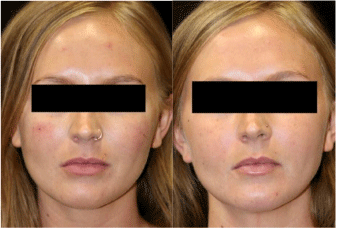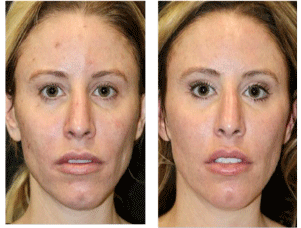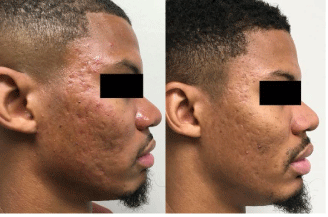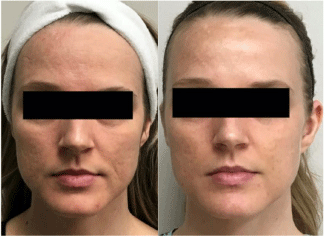The Utilization of a Nitric Oxide Generating Serum in the Treatment of Active Acne and Acne Scarred Patients?
Greg Chernoff*
Department of Otolaryngology, Head and Neck Surgery, St. Vincent Hospital, Indianapolis, Indiana, United States
*Address for Correspondence: Greg Chernoff, Department of Otolaryngology, Head and Neck Surgery, St. Vincent Hospital, United States, Tel: +1-949-838-4512; E-mail: [email protected]
Submitted: 29 March 2020; Approved: 29 April 2020; Published: 30 April 2020
Citation this article: Chernoff G. The Utilization of a Nitric Oxide Generating Serum in the Treatment of Active Acne and Acne Scarred Patients. Int J Pharma Anal Acta. 2020;3(1): 010-014.
Copyright: © 2020 Chernoff G. This is an open access article distributed under the Creative Commons Attribution License, which permits unrestricted use, distribution, and reproduction in any medium, provided the original work is properly cited
Keywords: Nitric oxide; Acne vulgaris; Topical application
Download Fulltext PDF
Active acne continues to be a problem affecting tens of millions of patients per year. Left untreated, the acne patient can develop permanent scarring. There is also a negative psychological impact on the selfesteem of the chronic acne patient.
Nitric oxide is necessary for optimal cellular health. Topical Nitric oxide can be produced without the generation of nitrogen dioxide, a known air pollutant. A novel patent pending nitric oxide generating serum was examined in this Pilot study (Pneuma Nitric Oxide, Austin, TX). This is the first NO generating topical serum of its’ kind. NO gas is produced on skin surface, by mixing equal amounts of the patent pending ingredients from each of the dual chambers on the skin. Nitric oxide is a free radical gas, produced endogenously from arginine by nitric oxide synthetase. Nitric oxide mediates vasodilation and inhibits platelet aggregation. As a result, Nitric oxide is a potent vasodilator, and increases blood flow via capillary recruitment. Topical Nitric oxide has anti-inflammatory effects as well as anti-bacterial and anti-viral properties. Topical Nitric oxide Serum over time, enhances the tone, quality and texture of skin, yielding a reduction in the appearance of acne scars, fine lines, static rhytids, enlarged pores, and unwanted pigment. When used prior to any other product, the vasodilatory property primes the skin to enhance the absorption of other products.
Ten patients (8 females, 2 males), were initially treated in a split face, double-blinded, placebo-controlled study to determine safety and efficacy. One side of the face was treated with the Nitric oxide generating serum. The contralateral side was treated with a glycerin gel of similar consistency to the NO serum. By 30 days, 9 out of 10 patients showed a reduced pustule and comedone count on the NO treated side compared to the control side. 8 out of 10 reported reduced erythema on the NO side compared to the control side. There were no allergic or hypersensitivity or irritant reactions reported. With efficacy and safety demonstrated, the full face study was initiated.
Thirty patients were treated in two centers between June, 2019 and January, 2020. There were 11 Caucasian, 4 Asian, 8 African American, 3 Hispanic, 2 Mediterranean, and 2 Indian Patients. There were 20 females and 10 males. Patients with facial and torso acne were examined. Patients were excluded if they had been on Accutane within one year of the Study, and were prevented from using any other acne product during the Study. The efficacy was evaluated by visual and instrumental methods at 4 week intervals for 16 weeks. Linear Analog Tests were administered. Tissue attributes examined were pustules, comedones, erythema, pigmentation, scar quality, skin texture, and overall appearance. Psychological measures included product satisfaction, self-esteem, and depression.
Nitric oxide serum was found to have a beneficial effect on the physical and negative psychological effects of acne. Reductions in comedones, pustules, erythema, and pigmentation were noted. Improvement in skin tone, texture and quality were reported. This resulted in the improvement of the appearance of scars in many patients. Overall satisfaction was high, with reports of increased selfesteem, and reduction of depression associated with acne-prone skin.
Introduction
Active acne… whether for a teenager, a birth-control affected patient, or a peri-menopausal female, remains a very negative feature, adversely affecting self-esteem in hundreds of millions of patients world-wide [1]. Most patients present extremely frustrated, having tried numerous over the counter products, multiple physician prescribed combinations, with little to no improvement. Some of the failure rests on the shoulders of non-compliance, some on the minimal success rates of the recommended protocols. The physical signs of acne lead to psychological symptoms, most commonly depression and decreased self-esteem. The complex interactions of infection, inflammation, tissue injury and wound healing provide a unique model to study scar pathophysiology.
Nitric Oxide (NO) is an important biological messenger in human physiology. This multifunctioning signaling molecule helps control vasodiation [2], and is involved in inhibiting platelet aggregation and adhesion [3,4]. Skin studies have shown that NO is involved in epidermal cell proliferation and differentiation [5]. NO is involved in regulating innate immune reactions, inflammatory responses, and controlling allergic skin manifestations, microbicidal activity and antigen presentation [6]. NO is a key player in regulating wound healing and tissue regeneration due to its’ gene regulation and its’ influence on the proliferation and differentiation of keratinocytes, fibroblasts, monocytes and macrophages [7-14]. Keratinocytes express inducible nitric oxide synthetase (iNOS), an enzyme that triggers the production of NO (15). NO plays a role in maintaining the skin’s barrier function,protects from UV radiation, and helps guide the healing process, leading immune cells to the wound site. [15]. Bryan has written extensively on the science and importance of NO in human health [16,17]. Much success has been shown with an oral repletion patented NO lozenge which generates NO (humanN, Austin, TX). Peer-reviewed, placebo controlled studies demonstrated that the NO lozenge could modify cardiovascular risk factors, reduce triglycerides, and reduce blood pressure in patients over 40 years of age [18]. These studies demonstrated the safety and efficacy of restoring NO production in humans.
A novel patent-pending nitric oxide generation serum (Pneuma Nitric Oxide, Austin, TX) was examined. The diffusion coefficient of NO is similar to other small diatomic molecules such as dioxygen or carbon monoxide [19]. A diffusion distance of 500 microns was established for NO in tissue [19]. This is adequate for NO to penetrate the dermis and reach the microcirculation of the upper horizontal plexus, and the upper dermis after topical application [20].
Study Population
Thirty patients were treated in two Centers between June, 2019 and January, 2020. There were 11 Caucasian, 4 Asian, 8 African American, 3 Hispanic, 2 Mediterranean, and 2 Indian patients. There were 20 females and 10 males. Patients with facial and torso acne were examined. Patients were excluded if they had been on Accutane within one year of the Study, and were prevented from using any other acne product during the Study.
Washout periods adhered to by subjects included 6 months free from dermabrasion, deep chemical peels, ablative laser treatments, neurotoxin or injectable fillers; 3 months free from non-ablative laser, light radiofrequency or ultrasound treatments; and 1 month free from microdermabrasion, light and medium depth peels. Patients were excluded if they had been on Accutane within one year of the Study, and were prevented from using any other acne product during the Study.
Methods
A novel “Patent Pending” NO generating dual chamber mixing serum was examined for preliminary efficacy and proof of concept. Equal quantities of serum were dispensed from each chamber onto the skin. The mixing of the patent pending ingredients are known to generate nitric oxide gas on the skin surface. Nitric oxide was detected and quantified using an ozone-based gas phase chemiluminescent detector (CLD); (EcoPhysics, Michigan, USA).
Contents of both chambers of the NO generating serum were dispensed and mixed on the skin. The CLD detector was placed one inch from the skin after the serum application Initial nitric oxide levels reached over 15,000 ppb during the mixing period, and then demonstrated normal decay kinetics. Nitric oxide could still be detected 30 minutes after the initial application.
Patients applied the Nitric oxide serum twice daily after washing their skin with a gentle cleanser. Standardized photographs were taken prior to initiating therapy and every 4 weeks thereafter for 16 weeks. Pustule and comedone counts were recorded every 4 weeks.
Figure 1 is an example of the Linear Analog Score that was administered to the patient every 4 weeks.
Results
There were no hypersensitivity, allergic or irritant reactions reported by any of the subjects.
Table 1 summarizes the results of the Linear Analog Tests for Measured Features. Numbers represent patient responses, and physician observer results.
A reduction in active acne was reported by 18% of patients by 4 weeks, 35% by 8 weeks, 49% by 12 weeks, and by 61% of patients by 16 weeks.
Decreased erythema was reported by 56% of patients at 4 weeks, 71% by 8 weeks, 78% by 12 weeks, and 83% by 16 weeks.
Decreased hyperpigmentation was reported by 67%of patients at 4 weeks, 74% by 8 weeks, 81% by 12 weeks, and by 86% of patients by 16 weeks.
Improved skin tone was reported by 25% of patients by 4 weeks, 46% by 8 weeks, 64% by 12 weeks, and by 78% of patients by 16 weeks.
Reduced appearance of scars was reported by 10% of patients at 4 weeks, 38% by 8 weeks, 61% by 12 weeks, and by 72% of patients by 16 weeks.
Interestingly, while these similar trends were reported by the observing physicians, the percentages of improvement were uniformly less. This would suggest more objectivity, and less of an emotional response by the treating doctors.
The psychological benefits of the Nitric oxide serum are also interesting. Improved self-esteem was reported by 31% of patients by 4 weeks, 54% by 8 weeks, 75% by 12 weeks, and by 81 % of patients by 16 weeks.
A reduction in perceived depression was reported by 10% of patients at 4 weeks, 24% of patients by 8 weeks, 49% of patients by 12 weeks, and 64% of patients by 16 weeks.
A feeling that less makeup was required to cover blemishes was reported by 50% of patients by 4 weeks, 66 % by 8 weeks, 85% by 12 weeks, and 90% of patients by 16 weeks.
Table 2 summarizes the results of the Linear Analog Tests for Patient Satisfaction measured.
There were no patients (0%) that described being unhappy with the product at 4,8,12, or 16 weeks.
Fifty-five percent (55%) of patients reported being “Satisfied” at 4 weeks, 26% were “Very Satisfied”, and 19% were “Extremely Happy” with the results at 4 weeks.
Thirteen percent (13%) of patients were “satisfied” at 8 weeks, 63% were “very satisfied”, and 24% were “Extremely Happy” with the results at 8 weeks.
Ten percent (10%) of patients were “Satisfied” at 12 weeks, 39% were “very satisfied”, and 51% were “Extremely Happy” with the results at 12 weeks.
Ten percent (10%) of patients were satisfied at 16 weeks, 22% were “Very Satisfied, and 68% were “Extremely Happy” with the product results at 16 weeks.
Discussion
The fields of Cellular Medicine, Regenerative and Stem Cell Therapies are growing rapidly [21]. Acne serves as a tremendous model for investigating infection prevention, inflammation, wound care, erythema, post-inflammatory hyperpigmentation, and the evolution of several types of scars. Current research, particularly in cellular medicine and regenerative therapy are seeking to further improve patient outcomes by enhancing prevention measures. Nitric oxide applied topically is capable of modulating the skins’ innate immune responses, decreasing inflammation, aiding in scavenging free radicals, and increasing fibroblastic proliferation while aiding in preserving the keratinocyte barrier function [5,7,9,11]. Any product which effectively decreases the inflammatory milieu will successfully aid in the treatment of acne.
Conclusion
Products containing naturally occurring ant-inflammatory, ant-oxidant, and pigment blending properties add a new tool in the armamentarium of the treating physician when it comes to active acne. This Nitric oxide generating serum can dramatically reduce active pustules, comedones, and improve the appearance of mild to moderate saucerized scars. By reducing inflammation and increasing keratinization, NO also increases moisture and barrier functions of the skin. The reduction of subclinical inflammation aids in the prevention of scar formation. It is safely applied on open wounds which yields added ant-bacterial activity, maximizing healing and minimizing scar formation.
- Qin M, Pirouz A, Kim MH, Krutzik SR, Garbán HJ, Kim J. P acnes induces IL 1beta secretion via the NLRP3 inflammable in human monocytes. J Invest Dermatol. 2014; 134: 381-388. PubMed: https://www.ncbi.nlm.nih.gov/pubmed/23884315
- Furchgott RF, Vanhoutte PM. Endothelium-derived relaxing and contracting factors. Faseb J. 1989; 3: 2007-2018. https://tinyurl.com/y9f943xo
- Radomski MW, Palmer RM, Moncada S. Endogenous nitric oxide inhibits human platelet adhesion to vascular endothelium. Lancet. 1987; 2: 1057-1058. PubMed: https://www.ncbi.nlm.nih.gov/pubmed/2889967
- Moncada S. Nitric oxide and cell respiration: Physiology and pathology. Verh K Acad Geneeskd Belg. 2000; 62: 171-179. PubMed: https://www.ncbi.nlm.nih.gov/pubmed/10905118
- Weller R. Nitric oxide: A key mediator in cutaneous physiology. Clin Exp Dermatol. 2003; 28: 511-514. PubMed: https://www.ncbi.nlm.nih.gov/pubmed/12950342
- Cals-Grierson MM, Ormerod AD. Nitric oxide function in the skin. Nitric Oxide. 2004; 10: 179-193. PubMed: https://www.ncbi.nlm.nih.gov/pubmed/15275864
- Frank S, Kämpfer H, Wetzler C, Pfeilschifter J. Nitric oxide drives skin repair: Novel functions of an established mediator. Kidney Int. 2002; 61: 882-888. PubMed: https://www.ncbi.nlm.nih.gov/pubmed/11849442
- Weller R, Price RJ, Ormerod AD, Benjamin N, Leifert C. Antimicrobial effect of acidified nitrite on dermatophyte fungi, Candida and bacterial skin pathogens. J Appl Microbiol. 2001; 90: 648-652. PubMed: https://www.ncbi.nlm.nih.gov/pubmed/11309079
- Rizk M, Witte MB, Barbul A. Nitric oxide and wound healing. World Journal of Surgery. 2004; 28: 301-304. https://tinyurl.com/y7hudfpl
- Liew FY, Cox FE. Nonspecific defense mechanism: the role of nitric oxide. Immunol Today. 1991; 12: A17–A21. PubMed: https://www.ncbi.nlm.nih.gov/pubmed/1712593
- Frank S, Kämpfer H, Wetzler C, Pfeilschifter J. Nitric oxide drives skin repair: Novel functions of an established mediator. Kidney Int. 2002; 61: 882-888. PubMed: https://www.ncbi.nlm.nih.gov/pubmed/11849442
- Fang FC. Nitric oxide and infection. New York: Kluwer Academic/Plenum Publishers; 1999. https://tinyurl.com/yazu953l
- Deliconstantinos G, Villiotou V, Fassitsas C. Ultraviolet-irradiated human endothelial cells elaborate nitric oxide that may evoke vasodilatory response. J Cardiovasc Pharmacol. 1992; 20: S63-S65. PubMed: https://www.ncbi.nlm.nih.gov/pubmed/1282989
- Frank S, Stallmeyer B, Kämpfer H, Kolb N, Pfeilschifter J. Nitric oxide triggers enhanced induction of vascular endothelial growth factor expression in cultured keratinocytes (HaCaT) and during cutaneous wound repair. FASEB J. 1999; 13: 2002-2014. PubMed: https://www.ncbi.nlm.nih.gov/pubmed/10544183
- Bryan NS, Tribble G, Angelov N. Oral microbiome and nitric oxide: the missing link in the management of blood pressure. Curr Hypertens Rep. 2017; 19: 33. https://www.ncbi.nlm.nih.gov/pubmed/28353075
- Bryan NS, Bian K, Murad F. Discovery of the nitric oxide signaling pathway and targets for drug development. Front Biosci (Landmark Ed). 2009; 14:1-18. PubMed: https://www.ncbi.nlm.nih.gov/pubmed/19273051
- Chernoff G, Bryan N, Park AM. Mesothelial stem cells and stromal vascular fraction use in functional disorders, wound healing, fat transfer, and other conditions. Facial Plast Surg Clin North Am. 2018; 26: 487-501. PubMed: https://www.ncbi.nlm.nih.gov/pubmed/30213429
- Zand J, Lanza F, Garg HK, Bryan NS. All-natural nitrite and nitrate containing dietary supplement promotes nitric oxide production and reduces triglycerides in humans. Nutr Res. 2011; 31: 262-269. PubMed: https://www.ncbi.nlm.nih.gov/pubmed/21530799
- Lancaster JR Jr. Simulation of the diffusion and reaction of endogenously produced nitric oxide. Proc Natl Acad Sci U S A. 1994; 91: 8137-8141. PubMed: https://www.ncbi.nlm.nih.gov/pubmed/8058769
- Suschek CV, Schewe T, Sies H, Kröncke KD. Nitrite, a naturally occurring precursor of nitric oxide that acts like a ‘prodrug’. Biol Chem. 2006; 387: 499-506. PubMed: https://www.ncbi.nlm.nih.gov/pubmed/16740120
- Chernoff G, Bryan N, Park AM. Mesothelial stem cells and stromal vascular fraction use in functional disorders, wound healing, fat transfer, and other conditions. Facial Plast Surg Clin North Am. 2018; 26: 487-501. PubMed: https://www.ncbi.nlm.nih.gov/pubmed/30213429








Sign up for Article Alerts